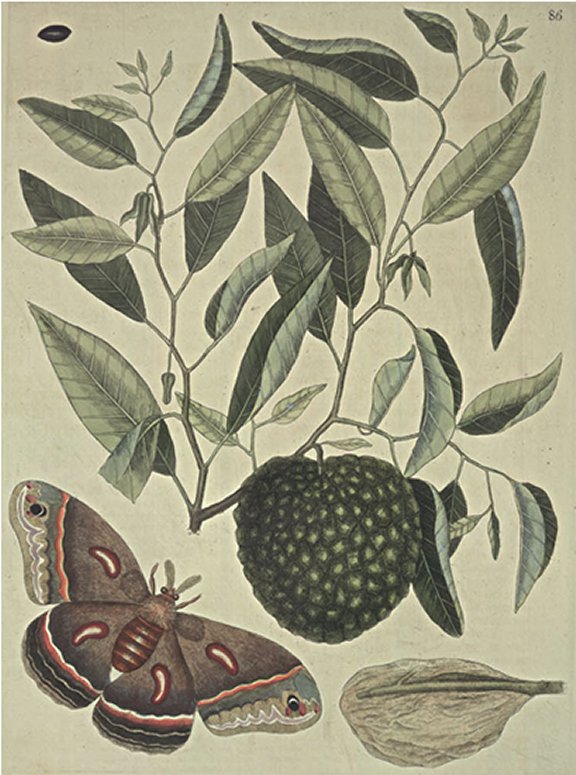Plate Number: II 86Anona maxima, foliis oblongis, angustis; fructu maximo luteo conoide;cortice glabro in areolas angulares distincto This differs from the Custard Apple, Hist. Jam. Vol. II. p. 167. in having the areolae angular, wereas those are round like the Scales of Fish. These Shrubs grow sometimes with a single Trunk, but more commonly they rise with several small Stems to the Height of about ten Feet, the Leaves are shaped like those of the Bay, set alternately on stiff slender Stalks, from which also hang single Flowers, consisting each of three greenish sharp-pointed Petals, the whole Plant has a strong foetid Smell. The Fruit when ripe is of a roundish conic Form, covered with angular Protuberances, within which is a sweet insipid Pulp, with several shining black Seeds lodged therein. The Fruit of this Tree is esteemed not unwholesome, and are eat by some People, but they serve mostly for Food to Guana's, and other Animals inhabiting the Bahama Islands, on which they grow. Phalaena magna, ex ruso &albo varia, Americana: The largest Carolina MothThis Moth has a large Body, the Abdomen is encompassed by five Rings of a muddy red Colour, the Eyes are large and spherical, the Legs six in Number and large, the Antennae broad and feathered, the Area or Ground Colour of all the Wings is of a reddish brown Colour, with these following additional Marks; in the Middle of every Wing is a large red and white Spot, in Form resembling a Kidney, one third of the lower Part of every Wing is bordered with alternate Lifts of white, red, yellow, black and brown, the further Corner of the two upper Wings have each an oval black Spot, in which is a semicircular white Mark. Thus much of its Description with the bare Figure is sufficient to distinguish this Butterfly. The Catterpillar of this Moth is enclosed by two Silk Bags of an oval Shape, the innermost smooth within, on the outside the Silk lying loose, and is covered by another Membrane of a thinner, smoother, and of a more compact Texture, and not of so uniform a Structure, as appears by the Figure, tho' they frequently vary in Size, and somewhat in Form. These Bags are found artfully fixed to the Twigs of Trees, some hanging pendant, others horizontally. This Moth is a Native of Carolina, and other Provinces more North. |